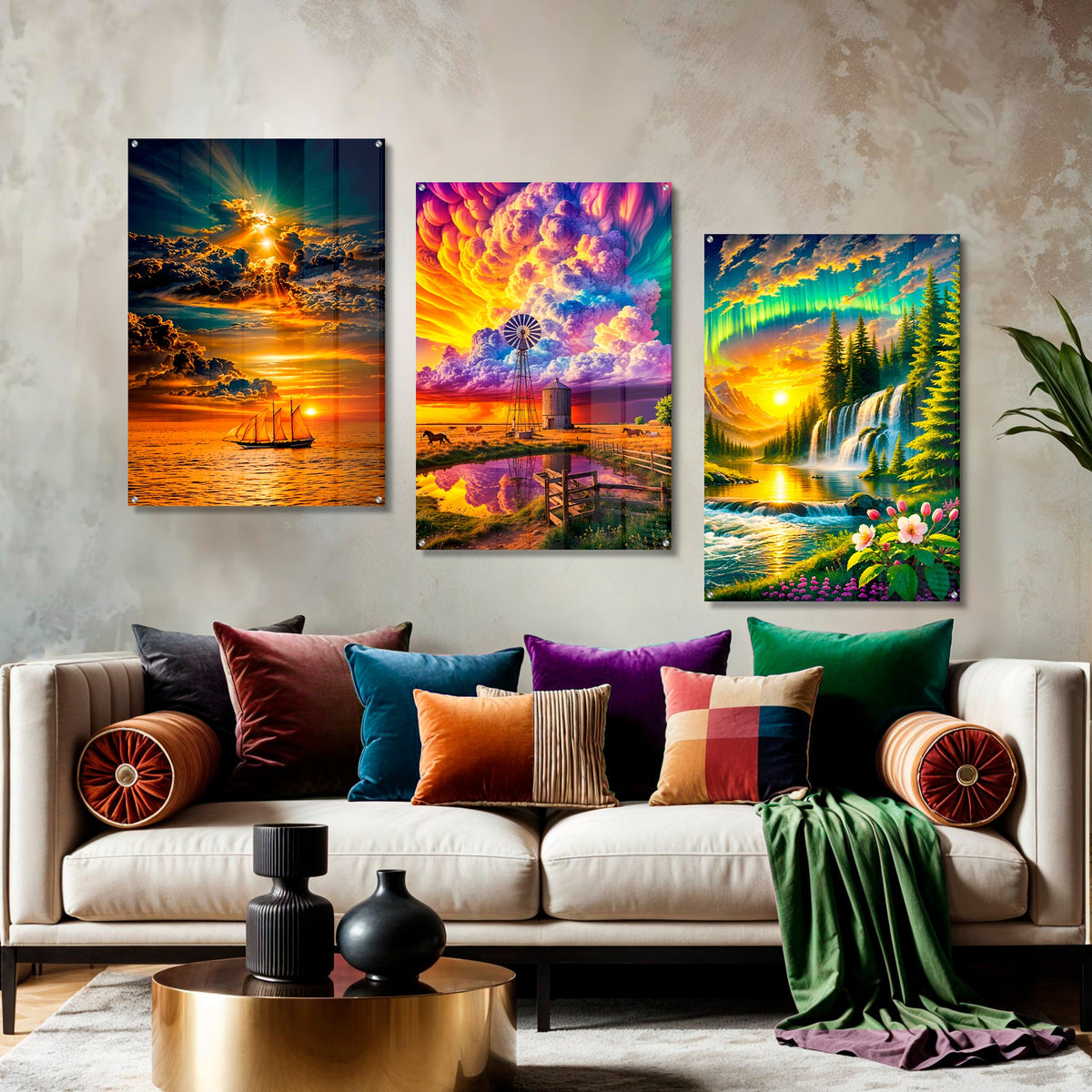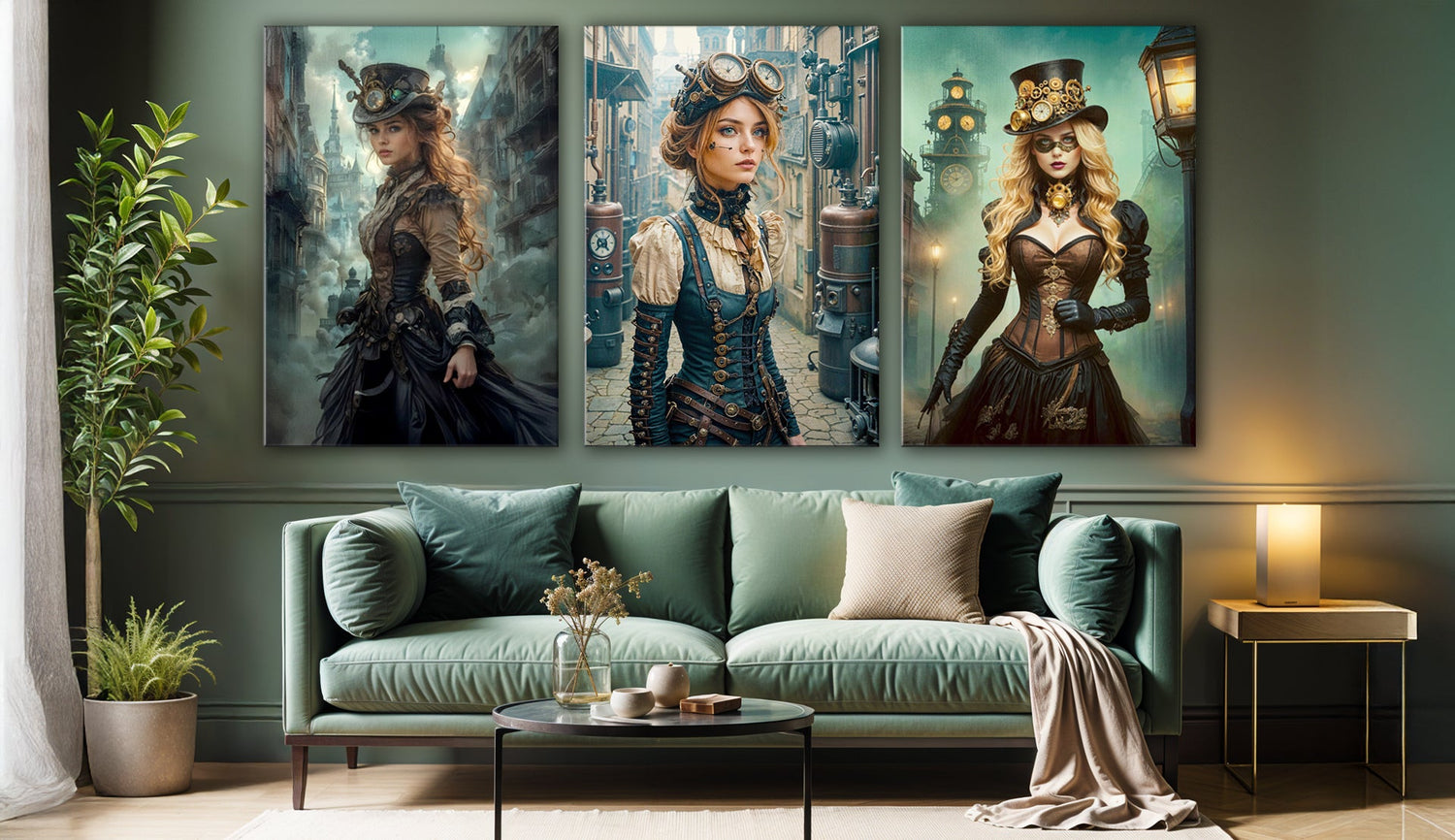
When Walls Carry the Horizon: A Trio of Acrylic Prints for the Modern Home
There are homes that feel finished the moment you walk in, and there are others where something feels incomplete, though you can’t quite name it. Often it’s the walls that give it away. Bare, they can feel clinical; covered too predictably, they risk fading into the background. The right art doesn’t just fill space—it changes how a room is felt. With this trio of acrylic prints—Colorful Countryside, Aurora Falls, and Dramatic Sunset Lonely Ship—the change is not subtle. These are images that lean into drama and light, sometimes to excess, but always with conviction.
A Conversation Between Land, Water, and Sky
Placed together, the three works span different landscapes. The prairie in Colorful Countryside is familiar in subject, but its skies swirl into colors that push the scene toward dreamlike intensity. Aurora Falls pulls the eye upward and downward at once, with water tumbling through dark evergreens under a sky split by northern lights. The Lonely Ship is perhaps the quietest of the trio, though no less striking: a vessel silhouetted against a sky fractured by golden light, moving forward alone.
For some viewers, the mix may feel uneven. A pastoral scene, a mountain valley, and a seascape don’t obviously belong side by side. But when seen as variations on light, they begin to connect. Each is less about what’s pictured and more about how atmosphere is transformed—the sky taking over, making landscape secondary.
What Acrylic Adds—and Complicates
Medium matters. Acrylic prints intensify light, colors seem to hover above the surface, and depth becomes more pronounced. This is not always a strength. In dim rooms where lamps bounce across glossy surfaces, reflections can distract. But in well-lit spaces, whether by daylight or balanced artificial light, the gloss allows these images to feel alive in a way matte canvas rarely achieves.
There’s also the question of longevity. Acrylic resists fading and humidity, meaning the prints could work in bathrooms or kitchens where paper would quickly degrade. Practical, yes, though some might argue that art’s value shouldn’t rest on practicality. Still, when buying with the hope of living with a piece for years, durability is no small consideration.
How They Shift Atmosphere
Each piece brings its own mood into a room. The countryside print adds scale, its clouds ballooning upward, giving even small living rooms a sense of vastness. The waterfall scene leans toward calm, and in a bedroom it might feel almost like a mural of serenity. The ship, when placed in an office or hallway, can suggest solitude or focus, the kind of atmosphere that suits a working space.
Displayed as a set, they create tension rather than harmony, but that tension has its own appeal. Rooms often flatten when all the art agrees; here, the differences keep the wall alive.

Rethinking Placement
The conventional row of three prints is reliable, but it risks making each piece look more like decoration than presence. Hung vertically, with the prairie at the top, the waterfall in the middle, and the ship at the base, the set reads almost like a layered story of horizon, forest, and sea. A diagonal across a hallway could introduce a sense of movement. Or the prints could be separated entirely, spread through different rooms, with their connection revealed only as one walks through the house.
These alternatives remind us that modern wall art doesn’t need to behave politely. Its value is often in how it shifts rhythm, not in how neatly it aligns.
A Small Hypothetical
Picture a spare guest room, tidy but bland. Pale walls, a neat bed, nothing offensive, but nothing memorable either. On one wall, the Lonely Ship is mounted. The next morning, when sunlight strikes it, the sails glow as if illuminated from within. The room doesn’t simply look different; it feels purposeful, as though it now offers an experience rather than a place to sleep. That is the kind of shift wall art can bring—not functional, but emotional.
Where It Might Not Work
To be fair, these are not prints for minimalists. The countryside clouds may feel excessive, too painterly to blend with muted interiors. The waterfall, with its blaze of aurora, borders on the fantastical, which might jar against modernist restraint. The ship, though less theatrical, still carries a weight that could overwhelm smaller rooms. But the critiques that call them “too much” also hint at their strength. They resist disappearing into the background.
Why the Trio Matters
Taken individually, each print can carry a space. Together, they stretch across moods and geographies: prairie, forest, and sea. They bring expansiveness indoors, a reminder that rooms can hold horizons as easily as furniture. It may be less about filling walls and more about making them breathe.
Closing Thought
Homes are built of structure and function, but they are lived in through atmosphere. The Colorful Countryside, Aurora Falls, and Lonely Ship prints don’t settle for neutrality. They offer a lot of spectacle, even if that means going too far. This boldness can be the missing piece that turns walls into experiences.







